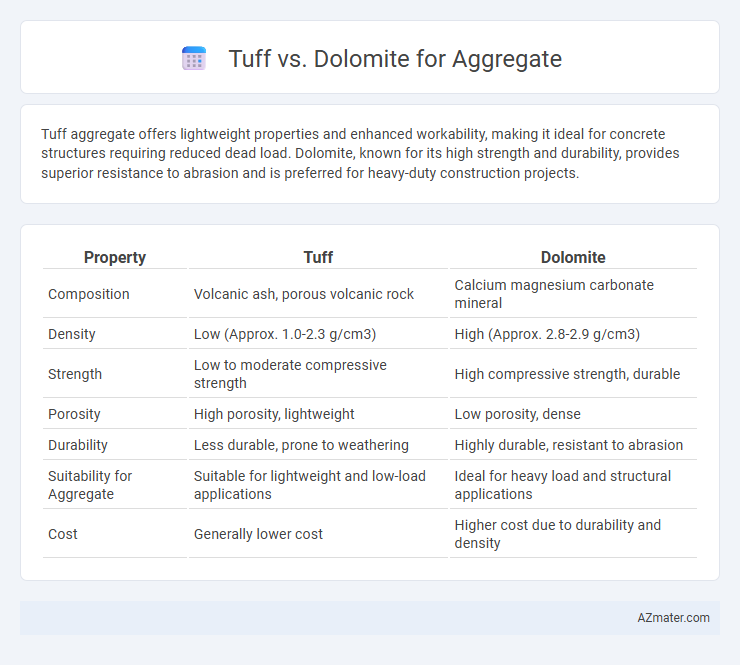Tuff aggregate offers lightweight properties and enhanced workability, making it ideal for concrete structures requiring reduced dead load. Dolomite, known for its high strength and durability, provides superior resistance to abrasion and is preferred for heavy-duty construction projects.
Table of Comparison
| Property | Tuff | Dolomite |
|---|---|---|
| Composition | Volcanic ash, porous volcanic rock | Calcium magnesium carbonate mineral |
| Density | Low (Approx. 1.0-2.3 g/cm3) | High (Approx. 2.8-2.9 g/cm3) |
| Strength | Low to moderate compressive strength | High compressive strength, durable |
| Porosity | High porosity, lightweight | Low porosity, dense |
| Durability | Less durable, prone to weathering | Highly durable, resistant to abrasion |
| Suitability for Aggregate | Suitable for lightweight and low-load applications | Ideal for heavy load and structural applications |
| Cost | Generally lower cost | Higher cost due to durability and density |
Introduction to Tuff and Dolomite as Aggregate Materials
Tuff and dolomite serve as essential aggregate materials in construction, with tuff being a volcanic rock characterized by its lightweight, porous structure, ideal for lightweight concrete and insulating applications. Dolomite, a sedimentary carbonate rock primarily composed of calcium magnesium carbonate, offers high durability and strength, making it suitable for road bases, concrete, and asphalt mixtures. The distinct mineral composition and physical properties of tuff and dolomite influence their performance in aggregate roles, affecting factors like compressive strength, density, and resistance to weathering.
Geological Formation and Composition of Tuff
Tuff, a volcanic rock formed from consolidated volcanic ash ejected during explosive eruptions, features a porous and lightweight structure composed primarily of volcanic glass fragments and mineral crystals such as feldspar and quartz. In contrast, dolomite, a sedimentary carbonate rock, originates from the chemical alteration of limestone through magnesium-rich fluids, resulting in a denser, crystalline composition dominated by the mineral dolomite (calcium magnesium carbonate). These fundamental geological differences influence their performance as aggregate materials, with tuff offering good thermal insulation and high porosity, while dolomite provides greater hardness and chemical stability.
Geological Formation and Composition of Dolomite
Dolomite is a sedimentary carbonate rock primarily composed of the mineral dolomite (CaMg(CO3)2), formed through the chemical alteration of limestone by magnesium-rich fluids during diagenesis. In contrast, tuff is a volcanic rock composed of consolidated volcanic ash and fragmented material, typically rich in silica and volcanic glass, originating from explosive eruptions. The geological formation of dolomite involves shallow marine environments with moderate to high salinity, promoting magnesium replacement in calcite crystals, whereas tuff's formation is linked to pyroclastic processes near volcanic activity.
Physical Properties Comparison: Tuff vs Dolomite
Tuff exhibits lower density and higher porosity compared to dolomite, resulting in reduced strength and durability as an aggregate. Dolomite's higher compressive strength and abrasion resistance make it more suitable for high-load construction applications. The water absorption rate in tuff is significantly greater, which can affect the longevity and performance of concrete structures.
Mechanical Strength and Durability Analysis
Tuff exhibits lower mechanical strength compared to dolomite, making dolomite a preferred choice for high-load construction projects requiring exceptional compressive strength typically above 150 MPa. Dolomite's dense crystal structure enhances its durability and resistance to weathering, outperforming tuff which tends to be more porous and prone to degradation under freeze-thaw cycles. In long-term infrastructure applications, dolomite's superior abrasion resistance and stability under mechanical stress ensure greater longevity and reduced maintenance costs compared to tuff aggregate.
Workability and Processing Differences
Tuff offers superior workability compared to dolomite due to its porous and lighter composition, facilitating easier cutting and shaping in construction applications. Dolomite is denser and harder, resulting in more intensive processing requirements such as crushing and grinding, which increase production time and equipment wear. The choice between tuff and dolomite impacts project efficiency, with tuff enabling faster handling while dolomite provides higher strength but demands more energy-intensive processing.
Aggregate Performance in Concrete Applications
Tuff and dolomite aggregates exhibit distinct performance characteristics in concrete applications, with tuff offering lightweight properties and superior thermal insulation due to its porous structure. Dolomite provides higher compressive strength and better resistance to abrasion, making it suitable for heavy-load concrete structures. Concrete incorporating dolomite aggregates tends to achieve enhanced durability and reduced permeability compared to tuff-based concrete, which may be preferable for non-structural or lightweight constructions.
Environmental Impacts of Tuff and Dolomite Extraction
Tuff extraction typically involves lower energy consumption due to its softer nature, resulting in reduced carbon emissions compared to the harder dolomite, which requires intensive blasting and crushing. Dolomite mining often leads to significant ecosystem disruption, including habitat loss and increased dust pollution, whereas tuff quarrying tends to have a smaller ecological footprint. Water pollution risks are present in both materials extraction, but dolomite's chemical composition can cause higher alkalinity, potentially affecting local aquatic environments more severely.
Cost and Availability in the Construction Market
Tuff is generally more cost-effective than dolomite due to its widespread availability and easier extraction processes, making it a preferred choice for budget-conscious construction projects. Dolomite, while offering superior durability and strength, tends to be pricier and less readily available, especially in regions without natural deposits. Construction markets prioritize tuff for large-scale aggregates where cost efficiency and accessibility outweigh the enhanced performance characteristics of dolomite.
Conclusion: Choosing the Right Aggregate for Your Project
Tuff and dolomite aggregates each offer unique benefits, with tuff providing lightweight characteristics and enhanced drainage, while dolomite excels in strength and durability for heavy-duty applications. Selecting the appropriate aggregate depends on project requirements such as load-bearing capacity, environmental conditions, and desired aesthetic outcomes. For structural integrity and long-term performance, dolomite is preferred, whereas tuff suits landscaping or low-impact construction where weight reduction is advantageous.

Infographic: Tuff vs Dolomite for Aggregate
 azmater.com
azmater.com